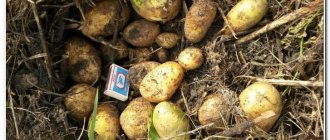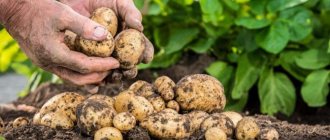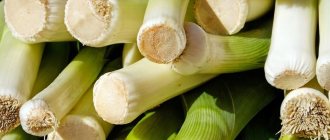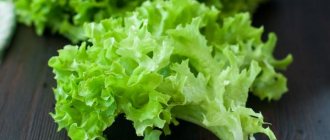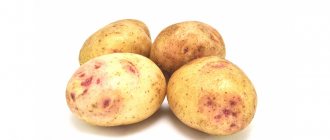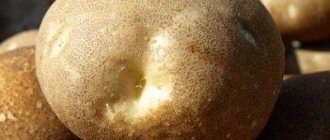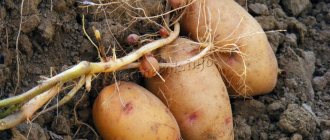Potato growing season
Few people know the biological feature of potatoes, which implies the presence of several phases during the ripening of the plant. In the first 20-25 days after planting, seedlings mature. And after this period, the potato growing season begins, which is divided into 4 phases.
- Budding. When the mass of the above-ground part of the plant reaches its maximum, gradual withering of the tops begins. The root system is actively forming.
- Bloom. The appearance of above-ground buds coincides with an active budding process deep underground. Underground tubers begin their development.
- Height. This is the main and longest period of the growing season, during which a systematic increase in tuber cells occurs. Depending on the potato variety and the above factors affecting the ripening period, this period can last from 40 to 65 days.
- Desiccation. This phase is marked by the death of the tops (occurs 60-90 days after planting). Advice! To speed up the ripening of tubers at this stage, it is necessary to remove the tops 10-12 days before harvesting.
Weather conditions when harvesting potatoes
Regardless of the potato variety you choose, the factors influencing early ripening and other features, the best weather for harvesting is warm and without precipitation. It is at this time that it is best to dig up tubers, since you can immediately start sorting them (dry potatoes are better cleared of soil).
Advice! Try to anticipate future climatic changes, since prolonged exposure to moisture during the desiccation period can spoil the potatoes and contribute to the appearance of rot on them.
The relationship between variety selection and harvest time
Based on the length of the growing season, potato varieties are divided into several groups.
Early ones form a harvest of marketable tubers 45-80 days after planting. This group is divided into ultra-early, early and mid-early varieties. The difference is when the potatoes ripen. In different subgroups, the ripening period can reach up to 10 days.
Gardeners most like varieties such as: Impala, Zhukovsky early, Bellarosa, Karatop, Arosa, Riviera, Red Scarlett, Talovsky 110.
All of these varieties have their own characteristics that must be taken into account. For example, the Impala variety is distinguished not only by early ripening, but also by high yield. Tubers with light brown skin and creamy yellow pulp can reach 160 g. It is also valuable for its relative resistance to potato cancer and nematode.
Zhukovsky early - an early variety of Russian selection is famous for its unpretentiousness and high taste (which allows it to be grown in all regions of Russia), the growing season is 70-80 days, it is resistant to potato nematode, cancer, rhizoctonia, and alternaria.
Bellarosa potatoes are widely known for their unsurpassed taste (5 on a five-point scale) and early ripening; in the southern regions, two harvests are possible.
One of the latest varieties of German selection, Karatop, is also interesting due to its fast ripening time.
Tubers of mid-season varieties ripen 80-85 days after planting. These are Aurora, Prince, Odysseus, Ogonyok, Kolobok, Nikulinsky.
Late potato varieties include Golubizna, Chaika, Orlenok, Symbol, Zhuravlinka, Limonka. They can be harvested 110 days after planting.
In order to be able to choose the right potato variety for your plot, you need to understand how potatoes grow. So, the biological feature of the root vegetable is the ability to form underground shoots. The ends of which, developing and thickening, turn into tubers. This is why potatoes are so demanding of loose, moderately moist soil. Root growth in such soil begins at a temperature not lower than 8 C. Potatoes are sensitive to frost. At a temperature of minus 1-1.5 C, the tops die. The best temperature during tuberization is 16-18 C. 2 weeks after flowering, tubers rapidly grow and starch accumulates in them. Due to the fact that the climatic conditions and soil composition in our country are diverse, preference should be given to zoned varieties. The highest ripening speed, yield, quality, resistance to diseases and pests will be where growing conditions are close to optimal.
In addition, it is sometimes necessary to replace varieties, many of which lose productivity after two to three years. It is better to use several varieties of potatoes with different readiness periods at the same time.
What determines the rate of tuber ripening?
But even if you choose a variety based on the ripening period of the tubers, after planting you cannot be sure that the harvest can be obtained by a specific date. The growing season is influenced by a large number of factors.
Factors that influence the growth rate:
- In what region is the vegetable grown?
- Planted potatoes will grow earlier if you plant the tubers in early May.
- Weather.
- Application of large amounts of mineral and organic fertilizers.
- The growing season of potatoes is shortened if you plant them in nutrient-poor soil. On fertile soil, growth does not accelerate, and the harvest can be harvested until late autumn.
- Lack of moisture also affects how quickly tubers grow. If the summer was dry and there was little rain, then the potato harvesting period is shortened.
If the growing season has been shortened for the last two reasons, then such potatoes will not be as tasty and will also be poorly stored. Therefore, if possible, it is advisable to regularly water the potatoes (if there is no rain in the summer) and before planting potatoes in open ground, add mineral and organic fertilizers to the ground. When the tubers ripen on time, they turn out tasty and can be stored for more than one month.
How long does it take for potatoes to grow?
Old-timers know everything about potatoes, but newcomers to vegetable growing will find it useful to know how long potatoes grow from planting to harvest, and what varieties to plant when to get the richest harvest possible.
How long do different potato varieties grow from planting to harvest?
Varieties according to ripening periods are:
- early, which include ultra-early, early-ripening and mid-early seed material;
- mid-season;
- mid-late;
- late.
Early ones, as a rule, are not all subject to long-term storage. They are mainly eaten immediately after digging, and root crops grown from mid-late and late species are put into winter storage.
Early
The ripening time of early potatoes can be determined by their varieties:
- The growing season of ultra-early varieties is 45-55 days after the first shoots appear, that is, the harvest can be dug up as early as late June - early July. Ultra-early varieties include such varieties as Ariel (root crops of this variety can be harvested several times during the summer), Impala, famous for its high yields, and Uladar, which is not demanding on soils.
- Early ripening, having a growing season of 60-70 days from planting to full ripening. These include the following varieties: Alena (has high resistance to fungal and bacterial diseases). Zhukovsky early is also resistant to numerous potato diseases. Lily with unsurpassed taste.
- The mid-early variety ripens from sowing in 75-80 days. These include: Arina, which is distinguished by its high taste, ease of care and resistance to diseases such as late blight and cancer. Red Scarlet, which also has excellent taste, high yield and resistance to a number of diseases; Luck, which is the most popular and sought-after species among the early varieties of the crop.
Mid-late
95-110 days after flowering, mid-late potato varieties ripen. It is not recommended to dig up potatoes of this type before the specified time. It is necessary to give it time to fully ripen and gain the greatest amount of dry matter.
The best mid-late varieties are Zhuravinka, which is undemanding to soil composition and resistant to a number of potato diseases; Asterix, which has excellent taste and excellent keeping quality; A seagull that produces high yields.
What determines the speed of potato ripening?
The timing of potato ripening is influenced by climatic conditions, planting dates and varieties of seed material.
There are no specific dates for planting seeds in the soil, since the weather is different every year. If, for example, the year before last, planting was carried out at the end of April, because it was early spring and the threat of return frosts passed early, then last year the spring was cold, it snowed in May and there were morning frosts, so the planting of seeds moved to the middle - the end of May.
Of course, the earlier potatoes are planted, the faster they will ripen, however, climatic factors must be taken into account. The rate of crop ripening is also affected by the amount of moisture and fertilizer applied.
Excess moisture and fertilizers will also not bring the desired result - with excessive watering, the tubers will begin to rot and the tops will grow too much, and excess feeding will lead to the accumulation of harmful nitrates in the root crops, which will not have time to ripen in time, therefore, everything should be in moderation.
How can I speed up the process?
Potatoes should grow until their tops dry out. Only then do they begin to harvest. It is not recommended to harvest root crops ahead of time, as pathogenic bacteria will develop on the fruits, which can cause the harvest to deteriorate. There is also no need to remove the tubers later - there is a risk of freezing.
https://youtube.com/watch?v=c_hINsRXH8k
In order for potatoes to ripen faster, they require high-quality care throughout the growing season. This means timely and competent watering and fertilizing. Under no circumstances should growth stimulants or chemicals be used. They give a short-term effect, and eating such potatoes is dangerous.
However, there are fairly safe ways to speed up the ripening of tubers. One of them is desiccation - artificial drying of the tops by spraying them with a solution of copper sulfate (50 g of the drug per 10 liters of water).
There is another way - senication. Its meaning is the same as for desiccation, only the tops are treated with an aqueous solution of superphosphate (2 kg of fertilizer is poured into 2 buckets of water and left for 2 hours, stirring occasionally). The tops are treated with this mixture in the evening.
If everything is in moderation, then the harvest will ripen quickly, and its quality will be at its best.
Conditions that determine the ripening period of tubers
Some gardeners develop potato tubers of the same variety at different times. Therefore, their maturation does not occur simultaneously. This phenomenon can be explained by the influence of external factors. After all, how long potatoes grow from planting to harvest depends on various factors.
Varietal features
Each variety of this vegetable crop has its own period and rate of tuber ripening. Before purchasing seed material, get acquainted with the botanical characteristics of the variety chosen for planting. In this case, special attention is paid to the time it takes to reach ripeness, the peculiarities of planting and the subtleties of care during plant development.
Growing region
In addition to the varietal characteristics of the vegetable crop, local climatic and weather conditions are taken into account before planting. In regions with an increased likelihood of frost in late spring, potatoes are planted later.
Boarding time
In our country, unexpected frosts often occur in the spring. Therefore, planting potatoes earlier than the date specified in the recommendation for the variety can lead to the death of plants from cold. When choosing a variety, it is necessary to take into account all its characteristics and features. It is better to plant potatoes of the selected variety on the recommended dates.
Feeding
Some novice gardeners, trying to speed up the achievement of maturity, overfeed potatoes with fertilizers. Usually such actions bring the opposite result. A large amount of organic matter in the soil reduces the quality of potato tubers and leads to the accumulation of nitrates in them. In conditions of deficiency of mineral complexes, the development of root crops is good, but their quality suffers. If the soil is saturated with inorganic compounds, the formation of tubers lags behind.
Air humidity and temperature
Too wet soil delays the ripening period of potatoes. Water saturates the tubers, so they continue to gain mass. If potato plantings are not irrigated regularly, the soil dries out and the above-ground part of the bushes stops developing. After the tops dry, the development of root crops accelerates and the ripening period is shortened.
Important! A sudden cold snap greatly reduces the quality of the crop. The number of small tubers increases.
Harvesting time and storage of potatoes
New potatoes, that is, potatoes that are purposefully dug up early for their smaller size and tender skin, are ready for harvest 2-3 weeks after the plants stop flowering. Young potatoes are not stored for long-term storage. It is even often torn from a bush by hand, leaving the bush to grow further.
Mature potatoes are harvested 2-3 weeks after the plant foliage has died. The tops of the plants should be completely dead before harvest, and the potatoes will have grown fairly thick skins. However, don't wait too long or the potatoes may rot (especially in soggy soil). The skin of mature potatoes is thick and adheres firmly to the pulp. If the skin is thin and easily rubbed off, the potatoes are not ripe. Such a vegetable will also be stored poorly. Potatoes in the ground can withstand even slight night frosts.
Dig up the crop on a dry day, being careful not to damage the tubers. Damaged potatoes are put aside separately; they are eaten first and are not suitable for long-term storage. If the soil is still wet at harvest time, the potatoes should be thoroughly dried, but not in the sun. Remember, it can turn green and solanine is formed in it and the potato will be bitter and poisonous. Dry it, preferably under a canopy at a temperature of 7-15°C.
Dried potatoes are stored for the winter, scattered in boxes. Store at a temperature of 6-10°C in a dark room with good ventilation. It is advisable: Do not store potatoes with apples, ethylene gas released by apples will lead to spoilage of potatoes.
The video shows another interesting and productive way of planting potatoes.
Growing potatoes will always be successful for you if you do everything correctly. You can experiment, but only in small beds. Let me remind you once again of the three basic rules:
- good seed material;
- properly germinated seed material;
- prepared mail.
Read what to cook from potatoes:
Good luck to you in your gardening business. High yields and environmentally friendly products.
I'm waiting for your comments. Subscribe to the site. Share with friends on social networks.
Features of harvesting
Potatoes are harvested separately by variety in dry, sunny weather, but not too early - when the morning frosts have passed and the air temperature has settled within +10...+17°C. Seed material is selected from the most productive and healthy bushes.
The dug up tubers are dried and sorted by size, discarding damaged and diseased ones. Root crops cut with a shovel can be left for drying and storage, and those damaged with a pitchfork can be taken for processing. Remains of tops and weeds must be collected and burned to prevent the development of diseases and contamination of the soil.
Dried and sorted potatoes are transported for storage in prepared and disinfected dark rooms with air temperatures up to +3°C and humidity up to 80%, with natural ventilation provided.
Did you know? Potatoes have a unique compatibility with other products. The number of first, second courses and desserts prepared from these root vegetables reaches two thousand.
Ripe and healthy tubers of early varieties, if harvested in a timely manner and properly stored, will easily retain their quality and nutrients until November, and late potatoes will successfully overwinter without losing their taste and benefits.
When to start digging potatoes in different regions of Russia
Most of Russia's territory is located in the zone of risky agriculture. Therefore, you need to choose a potato variety very carefully, giving preference to zoned varieties. True, there are varieties that are universal. Thus, according to statistics, almost 70% of owners of household plots located from Kuban to the Far East plant potatoes of the early Zhukovsky variety on their plots, which are characterized by high yield and resistance to weather conditions. Its only drawback is that the tubers begin to germinate at the slightest increase in temperature in the storage. If the autumn is warm, and the gardener delays harvesting, the potatoes may still germinate in the ground.
Potato harvest in central Russia
In the north of central Russia, frosts begin in the third ten days of September. Accordingly, it is better to harvest potatoes before mid-September. Although growing late varieties in such conditions is very risky, skilled summer residents are not afraid of difficulties: the mid-late varieties Pobeda, Nakra, Altair, Fambo are very popular. Of the early varieties that can be harvested at the end of August - beginning of September, home gardeners prefer Bashkir, Bellarosa, Nora, and Rosara.
In the south of central Russia, frosts occur later, at the beginning of October. The climate here is milder, so you can grow any variety of potatoes, even the latest ones. Of the late varieties, the varieties of Belarusian selection most loved by gardeners are Belorussky 3 and Lasunak, and of the mid-late varieties - Lorch, Mozart, Pobeda, Golubizna.
Potato harvest in Kuban
The southern regions have their own specifics
Here they pay more attention not to frost, but to the summer heat. From about mid-July, the temperature rises so much that potatoes in the ground stop growing
Therefore, in the south of Russia it is profitable to plant early and mid-early varieties that ripen before the end of July.
It has been experimentally established that the same Zhukovsky produces high yields only in the first year, then the variety degenerates, losing resistance to heat. But in these climatic conditions, the early varieties Cleopatra and Skoroplodny, as well as the mid-early ones: Svitanok Kyiv, Cardinal, Raj and Reserve, performed well. And Arrow is recognized as the most delicious of the early varieties grown in the Kuban.
Potato harvest in Crimea
Although the first frosts in Crimea begin only at the end of October, due to the hot climate here, as in Kuban, it is more profitable to grow early varieties. Crimean breeders specially developed a heat-resistant Crimean rose variety, ideal for local conditions.
If irrigation is organized on the site, then the heat-resistant early varieties Agave, Tiras, Laura, Arosa can produce two harvests per season in Crimean conditions: the first is harvested in June, the second in early October.
Potato harvest in the Urals and Siberia
In the Urals and Siberia, frosts begin in the second ten days of September. The climate is characterized by late spring frosts, possible July drought and heavy rains in August. Therefore, it is least risky to grow early and mid-early varieties, which can be harvested in the second or third ten days of August. The most common varieties here are Lugovskoy, Udacha (both frost- and drought-resistant), and Redstar.
Author of the article: Daria Kuznetsova, journalist and summer resident with 15 years of experience
The concept of early maturity of potatoes
To orient the user about the capabilities of certain varieties, terms have been introduced that characterize the duration of their cultivation:
- early and ultra-early grow within 50...65 days from planting to harvesting;
- mid-early potatoes grow longer, they need 65...80 days;
- mid-season varieties need a duration of 80...95 days;
- mid-late potatoes will grow in 95...110 days;
- Late-ripening potatoes take the longest to ripen; they remain in the soil for more than 110 days.
POTATO VARIETY RED STAR
Potato ripening time by variety
| Potato variety | Ripening time, days | Tuber weight, yield | Notes |
| Nevsky | 60…75 | 80…140 g, 250…360 c/ha | The bush can produce up to 15 tubers, good quality, recommended for the central zone of the Russian Federation and the Republic of Belarus, demanding on watering |
| Sorcerer | 55…70 | 75…200 g, 200…320 c/ha | Up to 12...15 tubers of different sizes are formed on the bush, recommended for the Moscow region, Middle Urals, Western Siberia, yields crops in dry years |
| Lorch | 90…115 | 60…100 g, 285…380 c/ha | Up to 20 tubers are formed on the bush, recommended for the Black Earth regions, demanding on soil fertility, responsive to fertilizing |
| Luck | 60…80 | 80…150 g, available up to 450 g, 250…450 c/ha | From 4 to 10 tubers of approximately the same size are formed on the bush, recommended for widespread cultivation, in the southern regions two harvests are obtained per year, demanding on soil moisture and fertility |
| Sineglazka | 70…95 | 75…100 g, 220…300 c/ha | An average of 8 tubers are formed per bush, recommended for the Central and Central Black Earth regions, excellent taste, shelf life up to 10 months, withstands drought |
| Rocco | 70…90 | 100..140 g, 260…450 c/ha | An average of 12 tubers per bush, leveled, recommended for the Black Earth Region. Excellent taste, resistant to late blight. The variety is recently grown, good consumer qualities |
| Slav | 80…105 | 120…180 g, 280…520 c/ha | On average, up to 10 tubers, demanding on watering and fertilizers, suitable for mechanized harvesting. Recommended for the Middle Zone, can be planted in the Urals and Siberia. |
| Kiwi | 75…100 | 100…120 g, 260…450 c/ha | The variety is resistant to wireworms and late blight, recommended for widespread use, good taste |
| Adretta | 70…90 | 80…110 g, 220…340 c/ha | Resistant to a whole range of diseases, produces an average of 8...10 tubers, recommended for all regions of the Russian Federation, excellent taste characteristics |
| Rosara | 65…75 | 80…110 g, 240…320 c/ha | There are 8...12 tubers on the bush, good taste, recommended for commercial use, two harvests per year, for the southern regions |
| Red Scarlett | 75…95 | 80…140 g, 350…620 c/ha | Recommended for Siberia, the Urals, the Far East, resists late blight, nematode, wireworm, excellent taste, red skin, yellow flesh |
| Timo | 65…75 | 75…130 g, 360…630 c/ha | One of the earliest varieties, recommended for the Urals and Siberia, showed excellent results in the central zone of the Russian Federation. A promising variety for widespread use, good storage, up to 8 months |
| Gloria | 75…100 | 60…95 g, 240…330 c/ha | There are 8...12 pink tubers on the bush, white flesh, excellent taste, recommended for frying, drought-resistant. For the Siberian and Ural regions |
| Ermak | 80…105 | 80…120 g, 230…290 c/ha | There are 6...9 tubers on the bush, not demanding on agricultural technology and fertilizing, stable yield, for the Central and Black Earth regions, resistant to late blight |
| Red Star | 85…110 | 90…115 g, 240…330 c/ha | There are up to 15 tubers on a bush, it is demanding on fertilizing and watering, excellent taste, recommended for general use |
How to speed up the ripening of potatoes?
You can try to speed up the ripening of potatoes after the flowering period so that young potatoes do not have to be dug up in late autumn. This will help those summer residents who have delayed planting planting material. You can also try to increase the growth of potatoes if it is a cold and rainy summer.
What to do if the bushes have grown a lot and you can’t delay harvesting?
- The easiest way is to cut off the green tops when the planting material has recently begun to sprout and the bushes have not yet begun to bloom.
- To ensure that potatoes ripen earlier, you can spray the bushes with a solution of copper sulfate 14 days before harvesting. The product draws moisture from the leaves and the maturity of the tubers comes faster. In the same month, the tops begin to become covered with brown spots, curl and dry out.
- You can speed up the ripening of potatoes if you have had a long and cold summer using magnesium chlorate. For 1 liter of water you need to take 25 grams, dilute the chlorate in water and spray the bushes with it. The stages of potato ripening will then be reduced, and after a while it will be possible to dig it up. If the weather is dry, then the potatoes ripen after spraying already on the 6th day.
- To ensure that potatoes ripen earlier than expected, they can be treated with superphosphate. Spray potatoes after flowering. For 1 liter of warm water 25 g of superphosphate. It is better to choose the time for the procedure in the evening.
- Tubers ripen faster if they are germinated before planting in the soil. This is not difficult to do and germination takes little time. Potatoes are germinated in a well-ventilated area. You can put straw or hay on the floor. During the day the temperature should be no more than +15. At night, for complete germination, it needs to be lowered to +7. Potatoes should germinate in 2–4 weeks. After the first roots begin to grow on the tubers, they are watered with a solution of sodium chloride, ammonium nitrate and superphosphate (15:15:55 per 10 liters of water). After two days, the tubers need to be watered. This will promote growth rate when the potatoes are planted in the soil.
- Drying is another way to speed up growth. The potatoes need to be spread out in one layer (it is not necessary to lay them out so that the sun hits the tubers). After a week and a half, eyes should appear on it. Then you can start planting. Plant dried potatoes in the usual way.
After these procedures, the stages of potato growth will be shortened and then you can safely dig up young potatoes without fear of damaging them in the ground. This question is especially relevant for those summer residents whose plot is located in a lowland, where water accumulates or when the ground contains a lot of peat and potatoes grow slowly.
Ways to accelerate potato ripening
Despite the fact that each potato variety ripens for as many days as intended by nature, the summer resident can intervene. The first rule is to plant green manure crops near potatoes. The term denotes crops that have a positive effect on seedlings near them. The second rule is that potato plantings are treated with chemicals in the morning or evening. Excessive cold or heat only harms. Compliance with the recommended concentration level of the substances used will help speed up the growing season of planted potatoes.
| Description | Description | Note |
| Adding superphosphate | For 10 liters of water take 2 kg of superphosphate | Treatment is carried out in the evening or at dawn. The second rule is that from the moment of sowing at least ½ of the required time period for ripening must pass. |
| Chlorate treatment | Early planted potatoes are subject to processing. For 1 liter of water take 20 g of magnesium chlorate | The manipulation is carried out after the end of the rainy season. |
| Mowing the tops | The manipulation is carried out 7 days before the potatoes ripen | The faster the seedlings are deprived of tops, the more nutrients they will direct to the development of tubers |
| Copper sulfate | For 1 liter of cold water take 5 g of the substance. Seedlings are treated 14 days before the harvest stage. | Copper sulfate accelerates the actual growing season of tops. By depriving it of nutrients and water, the substance causes it to wither |
| Weather | Taking into account the heavenly office will help you speed up the ripening of planted potatoes yourself. As was said earlier, ripened root vegetables can be harvested immediately after the tops have stopped flowering. If it also begins to dry out, then the summer resident must immediately get to work. Each potato should be removed from the ground in the evening on a fine day | Recommended temperature +12 + 17 C |
On a note!
Harvest dates depend on the rainy season. If the tops have not yet begun to dry out, and weather forecasters promise prolonged precipitation, then the summer resident does not have to wait for the final ripening of the root crops. You can harvest a little earlier. The main thing is to make sure that the tops have passed the peak of active growth.
Boarding time
With the arrival of warm spring days, gardeners rush to their plots, plow the ground with cultivators, dig with shovels and pitchforks, try to plant potatoes quickly (especially if their neighbor has already planted everything) and breathe a sigh of relief that the bulk of the work has been done. But there is a big catch here. Your neighbor may have:
- another land, more crumbly and sandy, which warms up faster in the sun;
- another variety, earlier and cold-resistant;
- Potatoes are planted prepared, sprouted, treated against diseases, beetles and underground pests.
Signs for planting tubers in the ground are:
- heating the soil at a depth of 10 cm by 10-12 degrees;
- air temperature outside is 17-20 degrees;
- the appearance on a birch tree of leaves the size of a penny coin.
On a note! Some amateur gardeners plant potatoes for early use in beds - boxes that are filled with compost in the fall and covered with black material for quick warming. Planting in such soil reduces the time from planting to obtaining marketable tubers by 2 weeks and increases the yield from 10 to 50%.
Selection of seed material in autumn and storage
When digging up potatoes, seed material is selected in advance for planting next year. Tubers should be:
- Healthy, without signs of disease.
- Have a beautiful round or oval shape; clumsy potatoes are not taken for planting.
- The size of a chicken egg, this is the size of the planting material that ensures good germination and nutrition for potato bushes as they grow. Too large potatoes do not germinate well, and small ones (less than 15-20 g) do not have enough strength and nutrition for all the buds to hatch and the tuber to sprout.
- Seed tubers are stored in a dry, dark, ventilated room at a temperature of +2 to +5 degrees. Increasing degrees during storage leads to germination of sprouts and loss of turgor in planting material.
Variety
Potatoes age and, if you constantly plant one variety on a plot, it degenerates over time, accumulates diseases and loses value. It is recommended to change seed material after 5-7 years. You should not chase advertised “high-yielding” varieties
When choosing seed material, experienced gardeners pay attention to:
- its precocity;
- recommendations for growing region;
- resistance to fungal diseases;
- productivity;
- the size of the tubers under the branch.
There are varieties:
- Early. You can dig up the crop 50-60 days after planting.
- Average. The harvest ripens in 80-90 days.
- Late. Tubers are dug out of the ground after 95-100 days.
In the southern regions, you can grow from early to late varieties. In areas with more harsh living and growing conditions, the choice is not so wide; late varieties do not ripen and are poorly stored. Therefore, when choosing a variety, gardeners focus on the weather conditions in their area and select several suitable ones for planting. It is undesirable to make do with only one; in the summer, unfavorable weather conditions may arise for it. But, when planting different varieties, you must follow the rules. Early varieties are not afraid of cold weather and are planted earlier, while late varieties are planted when warm weather sets in.
Preparing tubers for planting
The tubers are turned over from time to time so that the buds are awakened on all sides and lightly sprinkled with water or a nutrient solution with microdoses of fertilizers once a week. If the potatoes do not sprout at all, they are thrown away. Already at this stage, seed material whose green shoots have turned black is discarded. These are signs of tuber diseases:
- such seeds will not produce a full harvest;
- Planting diseased planting material can lead to diseases of the entire crop.
The method of germinating potatoes in wet sawdust reduces the time from planting to harvest. For this:
- sawdust purchased at a pet store (if you don’t have your own) is poured with boiling water and allowed to cool;
- pour a small layer of 5-7 cm on the bottom of the box or box;
- lay potato tubers in one layer;
- a 5-7 cm layer of sawdust is again poured on top and the tubers are placed on it and this is done until the very top of the container;
- place the box in a dark bag - a T-shirt, tie it at the top, leaving a small hole for air access;
- From time to time the bag is opened and the sawdust is moistened.
Attention! After a month, the planting material has not only green sprouts, but also roots, which allows the sprouts to quickly break through to sunlight.
Potato planting dates
Traditional
A rich potato harvest directly depends on the correct planting time. After all, favorable conditions have a great effect on plant growth and tuber formation.
As a rule, in our country these procedures coincide with the May holidays: thanks to the weekend, people have free time, which is so necessary for working in the garden.
However, you should not rely solely on this factor, because by this period the soil may not have had time to warm up yet, and the threat of night frosts remains, which negatively affects the germination of tubers.
If planted too early, plant development will be slowed down.
If planted early, due to insufficient heating of the soil, the development of the plant will be slowed down, but if planted late, moisture will evaporate from the ground. All this will negatively affect the harvest.
If planting dates are not observed, potatoes are affected by fungal diseases, so you need to carefully choose the time for planting tubers in the ground.
It is better to start work at a time when the soil warms up to 8 degrees to a depth of 10 centimeters. As a rule, at this time there is no longer a threat of severe frosts and the plant begins to fully develop. But the time when the earth will be warmed up to the required temperature directly depends on the climatic conditions of a particular region.
When to plant potatoes in the middle zone and Bashkiria
The optimal period for planting potatoes in the middle zone is, as a rule, at the end of the first ten days of May. It can continue until the beginning of June. But the experience of gardeners shows that even at late dates it was possible to harvest an excellent harvest, but this requires accompanying weather conditions.
READ ALSO: Yesterday's matches
In Bashkiria in the spring at the beginning of May, as a rule, sharp cold snaps occur, so there is no need to rush to plant tubers in the ground. It is recommended to wait for the onset of stable warmth, which comes after the May holidays. Based on this, the period for planting potatoes in this region is mid-May, the last one is June.
The recommended time for planting potatoes in Bashkiria is mid-May
Deadlines
The last dates for planting sprouted potato tubers in the ground vary depending on the region. In some areas, climatic conditions allow harvesting two crops, but this is a separate topic.
In order to reap an excellent harvest and not waste energy in vain, they try to plant planting material before mid-June. But in practice, there are cases of later planting. This can be done if it is possible to provide the plants with water. Otherwise, good tubers will no longer grow in overdried soil.
If potatoes are planted too early, there is a risk of seedlings being damaged by frost or plant development being inhibited.
But if planted late, due to lack of moisture, the tubers will not be able to develop normally and reach large sizes.
After how many days should I dig up potatoes?
When planting potatoes, it is important to consider your region of residence. In different areas, the time from planting to harvesting the same variety may vary due to differences in climate
Growing season by potato variety:
- Early potatoes, the ripening time of which is approximately 50–61 days after planting the tubers in the soil.
- The early ripening variety ripens 66–85 days from the moment of planting in the ground.
- The mid-season variety will ripen 86–95 days after planting.
- Medium late - from 96 to 115 days, after planting the tubers in the soil.
- The ripening period for late potatoes starts at 115 days.
The growing season may vary up or down. Again, this depends on the weather conditions during the season. It is impossible to influence this.
Signs of technical ripeness
Depending on weather conditions, potatoes may ripen earlier or later. You should not focus only on the growing season, which is indicated by the manufacturer in the description of the variety. Always look for other signs of root ripeness.
Pay attention to the condition of the tops, the size and weight of the tubers. A test dig is carried out. What signs are used to determine the ripeness of potatoes?
The main sign of technical ripening of root crops is wilting of leaves and stems, but the growing season of the crop must always be taken into account. The tops begin to dry out from the top and tend to the ground. If this phenomenon occurs too early, it may be a sign of an infectious disease.
The tops of the ultra-early crop begin to fade at the end of June, in mid-July. Early and mid-season root crops ripen at the end of July, in mid-August. Mid-late potatoes ripen at the end of September, at the beginning of October.
View this post on Instagram
Posted by @zhiznvglushi4 Sep 2021 at 2:32 PDT
To make sure that the potatoes are ripe, you can do a test dig. It is usually carried out 2 weeks before harvest. By this time, the tubers have reached their maximum size, but the skin remains thin. Potatoes can be eaten, but they are not quite ready for storage.
More on the topic: Which shovel to choose for digging potatoes?
It is left in the ground for the ripening period. Over the next 2-3 weeks, the maximum level of starch, vitamins, and mineral salts is concentrated in the pulp. The peel becomes dense. The tuber reaches its nominal weight.
When can you harvest?
A summer resident who regularly inspects the site monitors the condition of the tops. As soon as it begins to fade, they begin to harvest. It makes no sense to keep tubers for more than 21 days after the start of the active phase of withering of the tops. Skeptics say that potatoes will continue to grow without losing their taste. Botanists object. The prolonged presence of already ripened potatoes in the ground will make it impossible to store the crop for a long time after it has been harvested.
The second rule is that the tops do not always wither as cold weather approaches. If it happens that there is frost on a hike, and the deadlines are not met, you need to take action. The summer resident accelerates the ripening of seedlings. The faster this is done, the less chance there is of losing the harvest. Botanists urge caution. Acceleration of ripening is carried out taking into account the planted variety and soil characteristics.
Mowing tops and other ways to speed up potato ripening
One of the simple ways to avoid the situation when you have to dig new potatoes in the fall is to mow the tops while they are still green. This often happens during late planting or wet summers. As a result, tubers that have not formed a peel are easily wounded and poorly stored. If you cannot wait to harvest the potatoes, then carefully mow the tops no less than 7–10 days before digging. For the plant, this becomes a sign that the growing season is ending, and the tubers are ripening. The same procedure is followed if you have to use a potato digger or walk-behind tractor when harvesting.
On this topic:
BACK
FORWARD
1 of 81
Today, chemicals are also used to produce marketable potatoes at an early stage.
- When carrying out desiccation, two weeks before harvesting potatoes, the beds are sprayed with diluted copper sulfate at the rate of 5 grams per liter of water. The chemical literally sucks the moisture out of the greenery, causing the leaves to become stained and then curl and dry out.
- At the end of a long, cool summer, accompanied by frequent precipitation, the tops are treated with magnesium chlorate. The product is made at the rate of 20 grams of chemical per liter of water. If the weather remains dry, then after 5 days the green part of the plants dries out.
- Spraying potato bushes with superphosphate at the rate of 2 kg of product per 10 liters of water helps to accelerate the aging of tops. Irrigation is carried out in the daytime or evening after the flowering period, while 5 to 10 liters of chemical are consumed per hundred square meters.
These techniques will help you get high-quality tubers in the summer, when digging young potatoes is especially risky due to the high probability of mechanical damage.
Most of all, accelerating ripening is justified in peat bogs and low-lying areas, where in rainy summers it is difficult to obtain a healthy ripened crop.
Signs that the potato crop is ready for harvest
The degree of ripeness of the fruits of certain crops is usually quite easy to assess visually. But the situation is completely different with potatoes: try and find out whether they are ripe or not if the tubers are “sitting” in the ground! Fortunately, there are several signs that potato tubers are ready for harvesting, and we will list them now.
Yellowed tops
Yellowed and already beginning to dry tops on a potato bush is one of the most well-known “signals” that it’s time to dig up the potatoes. This indicates that the green part of the plant is already dying off, the tubers will no longer receive nutrients from it, which means they are ready for harvesting.
If the summer is hot, then the tops may turn yellow ahead of schedule - from too much sun. In this case, even if the bushes are already completely yellow, the tubers may still be immature.
Withered tops
The dying stems of a potato bush not only turn yellow, but also fall to the ground - a characteristic “collapse” is observed. This also serves as a signal that the potatoes are ripe and ready to harvest.
Wilted tops can mislead a gardener if the soil is waterlogged or oversaturated with nitrogen. The potato bushes will “die”, but the tubers will not yet be mature enough for digging and storage.
Tuber condition
If the condition of the tops can still deceive, then by the condition of the tubers you can easily find out whether it is time to dig potatoes. “Proper” potatoes should be hard, have a dense skin that cannot be scraped off with your finger, as is the case with new potatoes.
To check the potatoes, you need to carefully dig up several bushes in different areas of the garden plot and select the tubers with your hands.
It is important to remember that different potato varieties have different harvest times. Therefore, if potatoes were planted in the spring without separation by variety, by the time the tubers are dug up, it may turn out that the potatoes have ripened unevenly: in some places the bushes are still completely green, in some places they are yellow, and in some part of the garden they are completely dry
In this case, a serious problem arises with digging up potatoes, because you won’t actually be harvesting only from a couple of bushes “scattered” around the garden. Fortunately, there is a fairly simple solution available to every gardener: the potato tops need to be mowed, leaving “stumps” about 6-8 cm high, and then after 7-10 days you can dig up all the potatoes.
Mowing the tops will speed up the ripening of the tubers, while potatoes that have already managed to ripen will not have time to deteriorate in such a short time. As a result, you will be able to harvest different varieties of potatoes at the same time, which will make your work easier. By the way, mowing the tops is also useful if it is affected by late blight: mowing will help prevent infection of the tubers and improve their keeping quality; In this case, potatoes can be harvested after 2, or preferably 3, weeks.
The relationship between the potato variety and the timing of its harvest
Due to the fact that in different regions the period for planting vegetables may differ due to climatic conditions, the ripening period of potatoes is determined differently. In addition, in order to get a rich harvest in a particular area, you should also consider the type of potato before planting.
The growing season of potatoes and the speed of their ripening can be divided into the following categories:
- early variety - can be dug 50-65 days after planting;
- the growing season of mid-early potatoes is 65-80 days;
- A mid-season variety grows from planting to harvest from 80 to 95 days;
- mid-late potatoes from sowing to full ripening are in the ground for 95-110 days;
- The growing time for late-ripening tuber varieties is at least 110 days.
Therefore, it is necessary to choose a potato variety for each case separately. In addition, among the main factors influencing the harvest time, one can also highlight the growing season, taste, disease resistance, and the ability to survive the winter.
Ripening period
At the first signs of ripeness of root crops or after using a technique that is aimed at early ripening of potatoes, a ripening period is organized.
The tubers remain in the ground, nutrients are concentrated in the pulp, the amount of water decreases, and the peel becomes thicker. The following agrotechnical rules are defined for the ripening period:
- 2-3 weeks before harvesting, stop watering; the soil is moistened if it becomes very hard and prevents the tubers from developing;
- during the last watering, it is recommended to introduce superphosphate with potassium salt, mineral complexes or growth stimulants; fertilizers help increase productivity;
- to protect plants from infectious diseases at the end of the growing season, spray with a 5% solution of boric acid; acid improves the concentration of vitamins and mineral salts in the pulp of tubers, prolongs the shelf life of root crops, and prevents the spread of infections on bushes during ripening and tubers during storage.
More on the topic: What care does Rose potatoes require?
Potato care is stopped. With further watering, nutrients and starch are washed out of the soil and pulp. It becomes watery and tasteless. It contains a reduced amount of vitamins and mineral salts. These potatoes don't last long.
About the timing of ripening of garden crops
Most of the territory of the Russian Federation is located in the zone of risky agriculture. Approximately 35% is in the permafrost zone. It is not possible to grow anything.
Only the soil above thaws slightly to a shallow depth, and reindeer moss grows on it, which feeds deer and about three million inhabitants.
If we exclude the areas of mountains and forests, then a relatively small area of arable land will remain. More than 65% of this arable land is located north of 50° latitude. It is characterized by a relatively short summer, with few truly warm days, approximately 60...70.
The rest of the time it rains, the sky is covered with clouds. There is very little time left to grow many crops.
Of course, the plants have adapted and can grow from May to September. It is in such a short time that you need to meet it in order to have time not only to plant, but also to grow and harvest potatoes, as well as other vegetables, fruits and berries.
Planting and growing potatoes
Choosing the optimal place for planting potatoes
The first step is to choose a landing site. If you have chosen early varieties of potatoes, then the site for planting should be the one that dries out first in the spring. It needs to be prepared in the fall: dig it up and add fertilizer. The selected plot should not have been planted with potatoes in the previous year.
It is advisable to change the planting site annually to increase the yield, since the soil becomes depleted and requires additional fertilizer and care. The planting interval in one place should be at least 3-4 years. The area chosen for planting should have plenty of sunlight. The direction of the beds is oriented from north to south, thanks to this all the bushes will be evenly heated.
Choosing the optimal potato seedling
Potatoes are selected for planting in the fall; their weight should be at least 30 g and maximum 100 g.
You need to saturate the tubers with solanine; for this, about 12 days in the light. Such tubers should not be eaten as they can cause poisoning, but this substance protects the crop from bacteria and rodents.
Before planting, the tubers must be germinated in the light; this will take several weeks. In the first week, it is necessary to maintain the temperature at 16-18 degrees, and lower it in subsequent weeks. The minimum temperature should be 6 degrees.
Large batches of planting material are laid out on special racks, and small batches with eyes can be sent to the refrigerator for hardening. These activities are carried out 35 days before the start of planting potatoes.
Choosing a method of planting potatoes
There are 3 classic planting methods:
- trench;
- smooth;
- ridge
Trench
This is a good method for warm climates. When choosing a trench planting method, you need to take into account the condition of the soil. It should be light and sandy without excess moisture. Before planting, trenches are dug 15 cm deep, the distance between them should be 70 cm. Then tubers are laid in each trench every 35 cm, but if the potatoes are large, then the distance should be increased to 40 cm.
To ensure a better harvest, trenches can be dug in advance in the fall. For the winter, straw and manure are placed there and covered with earth. This will help nourish the soil. In addition, organic matter will warm the soil, and potatoes can be planted earlier than usual.
Smooth
One of the simplest planting methods, suitable for plains with a lot of sun. To plant potatoes the smooth way, you just need to remove the top layer of soil, place the tuber in the center, and cover it with soil again. The distance between plantings should be about 70 cm. It is most convenient to make the holes in a checkerboard pattern; in the future, this will make it easier to process the sprouts. The depth of the hole should be half the bayonet of a shovel.
Grebnevaya
Suitable for wet heavy soil. Instead of trenches, you will need to make ridges 15 cm high, the distance between the rows is 70 cm. Tubers are planted directly in the ridges 30 cm apart. This method of planting allows excess moisture to evaporate faster, due to which the potatoes will not rot in damp soil.
Preparing the soil for planting potatoes
Properly treated soil before planting guarantees a high yield in the future. First of all, it is better not to dig up the area unless absolutely necessary, this allows you to maintain soil fertility. The first treatment is carried out in mid-April and consists of feeding with organic fertilizers and loosening the soil. The second time you need to loosen the soil a week after the first treatment, the depth is 9 cm.
Next, using a flat cutter, you need to draw grooves, the distance between them is 70 cm. These are the future potato rows. Before planting potatoes, fertilizers are added to them. Then planting is carried out in the usual way, and then inter-row cultivation is necessary every 10 days.
Maintaining distance between rows when planting potatoes
The standard distance between rows is 70 cm, but may be less for ridge planting. In this case, the distance between the rows can be narrowed to the width of a shovel, which is approximately 26 cm. It is also worth considering the type of potato. Those that ripen more quickly can be planted 60 to 75 cm apart, while late varieties can be planted 70 to 90 cm apart between rows.
The distance between the bushes themselves depends on the variety. Early varieties can be planted closer together because they do not have as thick tops as later ones. The average distance between bushes is 26 cm, this parameter is taken at the rate of 6 bushes per 1 m2. But with this scheme you should not count on a very high yield. Ideally, the distance between plantings should be from 30 to 40 cm, depending on the size of the tubers and the potato variety.
Review
Each gardener has his own techniques and methods for growing potatoes. I want to share my experience. I prepare planting material in the fall. I select medium-sized tubers from a productive bush. I warm them up well in the light. I store them in the cellar, not allowing them to germinate before March. In March I bring boxes of tubers indoors. If the sprouts appear slowly, then I moisten them with warm water. This technique is good because you can immediately visually determine the fertility of these tubers in the future by the number and thickness of the sprouts. I plant in April while the soil is still moist. I pour a handful of ashes, onion peels, and garlic into the holes (I collect them all winter). If there is no humus, then a pinch of nitroammophoska. That's all the tricks. I remove weeds before emergence. And when green shoots appear, 15 cm high, I begin to loosen the soil and hill up the bushes. When the sprouts begin to set flower buds, I begin to water the beds well and do a second hilling. I periodically inspect the bushes, preventing the familiar Colorado potato beetle from appearing on them. And as a result, I get a huge harvest of even, large tubers. And the fact that my work was not in vain makes me happy!!!!
Why is it important to harvest carrots on time?
A decrease in air temperature at the end of August (beginning of September) stops the growth of the green root crop, from this moment the vegetable begins to gain strength, absorbing vitamins, microelements and other useful substances as much as possible. If you dig up carrots too early, they will not be fully ripe, and storing them until the next harvest will be problematic.
Important! Experienced gardeners say that if white hairs are visible on a dug carrot, it is ready for harvesting.
But it is also not recommended to keep the root crop in the ground for longer than expected: the taste deteriorates, new roots are formed, which indicates its secondary growth.
Information One of the important characteristics of carrots is frost resistance, but keeping them in beds below minus 2 degrees is not recommended due to the possible appearance of rot.
What affects the timing of potato emergence?
After planting, a potato bush begins to form from seedlings or dormant eyes. How soon the seedlings appear depends on many reasons; experienced summer residents will confirm that the timing of the emergence of seedlings is most influenced by 2 factors:
- Correct assessment of the weather situation and choice of timing for planting potatoes.
- Use of high-quality seed material and additional pre-planting preparation of seed tubers.
Hoping for warm weather and planting potatoes “early and quickly” directly from the cellar is a sure way to get weak, late shoots with “bald spots” and a very dubious return of tubers from the garden in the fall.
